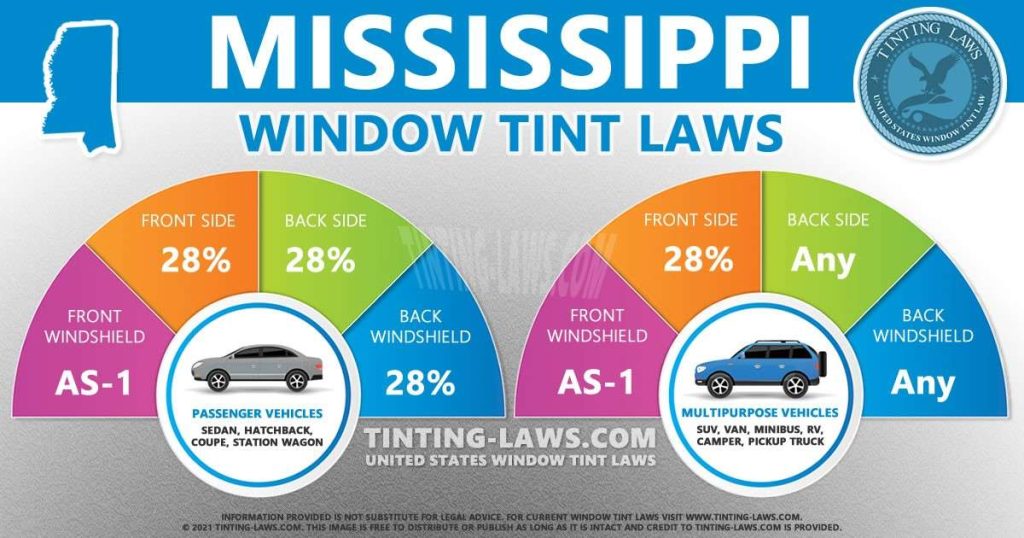Mississippi Window Tinting Laws
Car window tinting laws in Mississippi were enacted in 1988, and amended in 2006.
We have provided all the necessary information about your car’s window tint, including how dark or reflective the tint is allowed in your state.
There are also additional car window tinting rules and regulations in Mississippi so make sure you read all about it below.
Window tint darkness in Mississippi
The percent of visible light allowed through your car windows is called VLT: Visible Light Transmission.
The percentage of light allowed through your film and glass in Mississippi is very specific and different for sedan cars and SUV cars or vans.
Tint darkness for sedans:
- Windshield: Non-reflective tint is allowed above the manufacturer’s AS-1 line.
- Front Side windows: Must allow more than 28% of light in.
- Back Side windows: Must allow more than 28% of light in.
- Rear Window: Must allow more than 28% of light in.
Tint darkness for SUV and vans:
- Windshield: Non-reflective tint is allowed above the manufacturer’s AS-1 line.
- Front Side windows: Must allow more than 28% of light in.
- Back Side windows: Any darkness can be used.
- Rear Window: Any darkness can be used.
Window tint reflection in Mississippi
Window tint can reflect incoming light and reduce glare and heat.
Mississippi window tint law permits a certain window reflection when using a tint so make sure you pay attention to this as well.
Tint reflection for sedans:
- Front Side windows: Must not be more than 20% reflective.
- Back Side windows: Must not be more than 20% reflective.
Tint reflection for SUV and vans:
- Front Side windows: Must not be more than 20% reflective.
- Back Side windows: Must not be more than 20% reflective.
Other Mississippi window tint rules and regulations:
Mississippi does have several other important laws, rules and regulations pertaining to window tinting. They include the following:
- Side Mirrors: No restrictions.
- Restricted Colors: You can use all tint colors.
- Certificates: Manufacturers of film need to certify the film they sell in the state. Check with your dealer to confirm they are using certified film.
- Stickers: Sticker certifying that all window have a light transmittance of 28% or more must be on windshield.
- Medical Exceptions: Mississippi permits medical exemptions for special tint.
- Penalties: Fine up to $1000, or imprisonment in county jail up to 3 months, or both.
Keep in mind that Mississippi tinting laws and regulations may be interpreted differently in your county or place of residence.
We always recommend double-checking our information with your local DMV or law enforcement authorities.

Our information about window tint laws in Mississippi was last updated in 2024.
Tinting laws in Mississippi were enacted in 1988, and amended in 2006.
In case any of our info provided is not up to date or correct be sure to contact us so we can fix it. Thanks!
Trusted industry leader in providing accurate window tint laws. Share with confidence:
State of Mississippi Info
Mississippiis a U.S. state located in the Southern United States.
Jackson is the state capital and largest city. The name of the state derives from the Mississippi River, which flows along its western boundary, whose name comes from the Ojibwe word misi-ziibi (“Great River”).

Mississippi is the 32nd most extensive and the 31st most populous of the 50 United States.
Capital: Jackson
Population: 2,984,926
Area: 48,430 sq mi (125,443 km2)
Cities in Mississippi: Jackson, Biloxi, Hattiesburg, Gulfport, Tupelo, Natchez, Vicksburg, Meridian, Pascagoula, Starkville, Ocean Springs, Southaven, Oxford, Clarksdale, Tunica, Ridgeland, Columbus, Greenville, Olive Branch, Jetts, Philadelphia, Pearl, Long Beach, Laurel, Bay St. Louis, Madison, Greenwood, Brandon, Corinth, Pass Christian, McComb, Picayune, Flowood, Moss Point, Clinton, Yazoo City, Hernando, Cleveland, Adelle, Canton, Grenada, Holly Springs, Batesville, Renova, Gloster, Kosciusko, Brookhaven, Harmontown, Horn Lake, New Albany
Counties in Mississippi: Adams, Alcorn, Amite, Attala, Benton, Bolivar, Calhoun, Carroll, Chickasaw, Chocktaw, Claiborne, Clarke, Clay, Coahoma, Copiah, Covington, DeSoto, Forrest, Franklin, George, Greene, Grenada, Hancock, Harrison, Hinds, Holmes, Humphreys, Issaquena, Itawamba, Jackson, Jasper, Jefferson, Jefferson Davis, Jones, Kemper, Lafayette, Lamar, Lauderdale, Lawrence, Leake, Lee, Leflore, Lincoln, Lowndes, Madison, Marion, Marshall, Monroe, Montgomery, Nashoba, Netton, Nexubee, Oktibbeha, Panola, Pearl River, Perry, Pike, Pontotoc, Prentiss, Quitman, Rankin, Scott, Sharkey, Simpson, Smith, Stone, Sunflower, Tallahatchie, Tate, Tippah, Tishomingo, Tunica, Union, Walthall, Warren, Washington, Webster, Wilkinston, Winston, Yalobusha, Yazoo
Tint law references:
Mississippi Code section 63-7-59: Windows and window glass generally